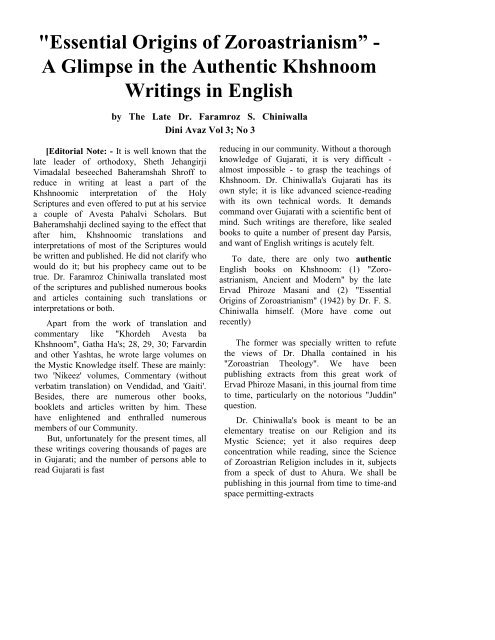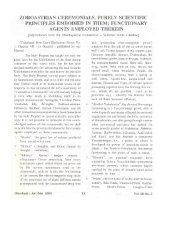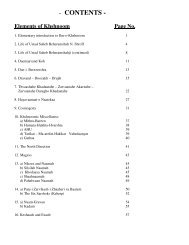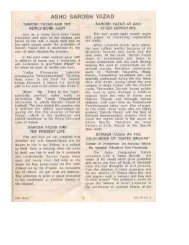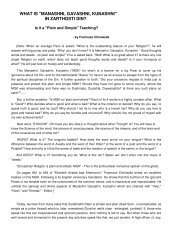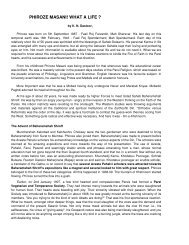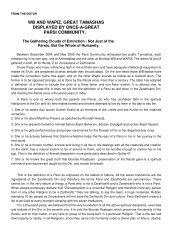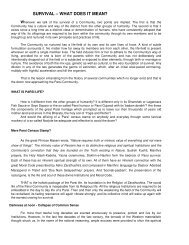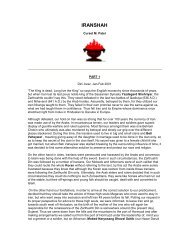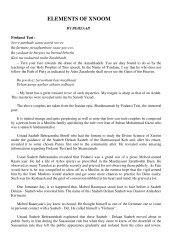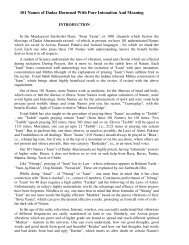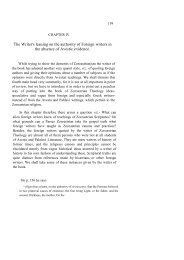"Essential Origins of Zoroastrianism” - A Glimpse in the Authentic ...
"Essential Origins of Zoroastrianism” - A Glimpse in the Authentic ...
"Essential Origins of Zoroastrianism” - A Glimpse in the Authentic ...
Create successful ePaper yourself
Turn your PDF publications into a flip-book with our unique Google optimized e-Paper software.
"<strong>Essential</strong> <strong>Orig<strong>in</strong>s</strong> <strong>of</strong> <strong>Zoroastrianism”</strong> -<br />
A <strong>Glimpse</strong> <strong>in</strong> <strong>the</strong> Au<strong>the</strong>ntic Khshnoom<br />
Writ<strong>in</strong>gs <strong>in</strong> English<br />
by The Late Dr. Faramroz S. Ch<strong>in</strong>iwalla<br />
D<strong>in</strong>i Avaz Vol 3; No 3<br />
[Editorial Note: - It is well known that <strong>the</strong><br />
late leader <strong>of</strong> orthodoxy, Sheth Jehangirji<br />
Vimadalal beseeched Baheramshah Shr<strong>of</strong>f to<br />
reduce <strong>in</strong> writ<strong>in</strong>g at least a part <strong>of</strong> <strong>the</strong><br />
Khshnoomic <strong>in</strong>terpretation <strong>of</strong> <strong>the</strong> Holy<br />
Scriptures and even <strong>of</strong>fered to put at his service<br />
a couple <strong>of</strong> Avesta Pahalvi Scholars. But<br />
Baheramshahji decl<strong>in</strong>ed say<strong>in</strong>g to <strong>the</strong> effect that<br />
after him, Khshnoomic translations and<br />
<strong>in</strong>terpretations <strong>of</strong> most <strong>of</strong> <strong>the</strong> Scriptures would<br />
be written and published. He did not clarify who<br />
would do it; but his prophecy came out to be<br />
true. Dr. Faramroz Ch<strong>in</strong>iwalla translated most<br />
<strong>of</strong> <strong>the</strong> scriptures and published numerous books<br />
and articles conta<strong>in</strong><strong>in</strong>g such translations or<br />
<strong>in</strong>terpretations or both.<br />
Apart from <strong>the</strong> work <strong>of</strong> translation and<br />
commentary like "Khordeh Avesta ba<br />
Khshnoom", Gatha Ha's; 28, 29, 30; Farvard<strong>in</strong><br />
and o<strong>the</strong>r Yashtas, he wrote large volumes on<br />
<strong>the</strong> Mystic Knowledge itself. These are ma<strong>in</strong>ly:<br />
two 'Nikeez' volumes, Commentary (without<br />
verbatim translation) on Vendidad, and 'Gaiti'.<br />
Besides, <strong>the</strong>re are numerous o<strong>the</strong>r books,<br />
booklets and articles written by him. These<br />
have enlightened and enthralled numerous<br />
members <strong>of</strong> our Community.<br />
But, unfortunately for <strong>the</strong> present times, all<br />
<strong>the</strong>se writ<strong>in</strong>gs cover<strong>in</strong>g thousands <strong>of</strong> pages are<br />
<strong>in</strong> Gujarati; and <strong>the</strong> number <strong>of</strong> persons able to<br />
read Gujarati is fast<br />
reduc<strong>in</strong>g <strong>in</strong> our community. Without a thorough<br />
knowledge <strong>of</strong> Gujarati, it is very difficult -<br />
almost impossible - to grasp <strong>the</strong> teach<strong>in</strong>gs <strong>of</strong><br />
Khshnoom. Dr. Ch<strong>in</strong>iwalla's Gujarati has its<br />
own style; it is like advanced science-read<strong>in</strong>g<br />
with its own technical words. It demands<br />
command over Gujarati with a scientific bent <strong>of</strong><br />
m<strong>in</strong>d. Such writ<strong>in</strong>gs are <strong>the</strong>refore, like sealed<br />
books to quite a number <strong>of</strong> present day Parsis,<br />
and want <strong>of</strong> English writ<strong>in</strong>gs is acutely felt.<br />
To date, <strong>the</strong>re are only two au<strong>the</strong>ntic<br />
English books on Khshnoom: (1) "Zoroastrianism,<br />
Ancient and Modern" by <strong>the</strong> late<br />
Ervad Phiroze Masani and (2) "<strong>Essential</strong><br />
<strong>Orig<strong>in</strong>s</strong> <strong>of</strong> Zoroastrianism" (1942) by Dr. F. S.<br />
Ch<strong>in</strong>iwalla himself. (More have come out<br />
recently)<br />
The former was specially written to refute<br />
<strong>the</strong> views <strong>of</strong> Dr. Dhalla conta<strong>in</strong>ed <strong>in</strong> his<br />
"Zoroastrian Theology". We have been<br />
publish<strong>in</strong>g extracts from this great work <strong>of</strong><br />
Ervad Phiroze Masani, <strong>in</strong> this journal from time<br />
to time, particularly on <strong>the</strong> notorious "Judd<strong>in</strong>"<br />
question.<br />
Dr. Ch<strong>in</strong>iwalla's book is meant to be an<br />
elementary treatise on our Religion and its<br />
Mystic Science; yet it also requires deep<br />
concentration while read<strong>in</strong>g, s<strong>in</strong>ce <strong>the</strong> Science<br />
<strong>of</strong> Zoroastrian Religion <strong>in</strong>cludes <strong>in</strong> it, subjects<br />
from a speck <strong>of</strong> dust to Ahura. We shall be<br />
publish<strong>in</strong>g <strong>in</strong> this journal from time to time-and<br />
space permitt<strong>in</strong>g-extracts
from this book with explanatory notes whereever<br />
needed.<br />
Below is an extract from <strong>the</strong> first pages <strong>of</strong><br />
<strong>the</strong> book elucidat<strong>in</strong>g <strong>the</strong> source <strong>of</strong> this Mystic<br />
and Div<strong>in</strong>e Knowledge <strong>of</strong> our Religion, <strong>in</strong><br />
o<strong>the</strong>r words called Ilm-e-Khshnoom.]<br />
The_ orig<strong>in</strong>al teach<strong>in</strong>gs <strong>of</strong> <strong>the</strong> Zoroastrian<br />
Religion as current <strong>in</strong> its Empire Days are<br />
shrouded <strong>in</strong> oblivion. The present day<br />
exposition <strong>of</strong> <strong>the</strong> Religion as expla<strong>in</strong>ed by <strong>the</strong><br />
Western methods is much <strong>of</strong>f <strong>the</strong> mark. It is<br />
apparently known to <strong>the</strong> world that everyth<strong>in</strong>g<br />
Zoroastrian, but <strong>the</strong> meager existence <strong>of</strong> <strong>the</strong><br />
Parsis <strong>in</strong> India, is lost to <strong>the</strong> world. Though <strong>the</strong><br />
great Zoroastrian Em<br />
pire and Nations are non- existent, <strong>the</strong> Great<br />
Zoroastrian sages called" Sahebe-Dilan"<br />
are still <strong>in</strong> existence <strong>in</strong> <strong>the</strong> mouta<strong>in</strong> recesses<br />
<strong>of</strong> Persia, as Kuhe-Demavand and o<strong>the</strong>r<br />
peaks, hav<strong>in</strong>g <strong>the</strong> old religion and its teach<strong>in</strong>gs<br />
<strong>in</strong>tact with <strong>the</strong>m. These sages have kept <strong>the</strong>mselves<br />
secluded from <strong>the</strong> rest <strong>of</strong> <strong>the</strong> world, and<br />
are unapproachable by any human be<strong>in</strong>g, as<br />
<strong>the</strong>y have created round about <strong>the</strong>ir places<br />
talismanic r<strong>in</strong>gs called" Karsh" <strong>in</strong> <strong>the</strong> Avestaic<br />
lore. 1t is said that <strong>the</strong>se sages send <strong>the</strong>ir<br />
emissaries every three years to <strong>the</strong> outer world<br />
to purchase for <strong>the</strong>mselves some necessaries <strong>of</strong><br />
life <strong>in</strong> exchange for some articles, which <strong>the</strong>ir<br />
own people produce. The special Zoroastrian<br />
Clan (The Saheb-Dilan), <strong>of</strong> which I am<br />
speak<strong>in</strong>g, consists <strong>of</strong> about 2,000 members, <strong>in</strong><br />
which 72 <strong>in</strong>dividuals called Maghav (Magi)<br />
are <strong>of</strong> <strong>the</strong> highest rank. The rest <strong>the</strong> laity are all<br />
righteous and truthful, liv<strong>in</strong>g <strong>in</strong> perfect<br />
obedience to <strong>the</strong>ir master called 'Sroshavarz'<br />
and rema<strong>in</strong><strong>in</strong>g engaged <strong>in</strong> prayers, and spend<br />
<strong>the</strong>ir prescribed time <strong>in</strong> <strong>the</strong> pursuits <strong>of</strong><br />
agriculture and <strong>the</strong> production <strong>of</strong> bare necessities<br />
<strong>of</strong> life as understood by <strong>the</strong>m.<br />
Our late Ustad (Guru) Mr. Behramshah<br />
Navroji Shr<strong>of</strong>f, a Parsi resident <strong>of</strong> Surat, was<br />
<strong>in</strong>duced by <strong>the</strong>m, at <strong>the</strong> age <strong>of</strong> 18 years by<br />
some <strong>in</strong>explicable Law <strong>of</strong> Nature, to accomp-<br />
any <strong>the</strong>m to <strong>the</strong>ir talismanic residence, where he<br />
was allowed to stay with <strong>the</strong>m <strong>in</strong> <strong>the</strong>ir bountiful<br />
<strong>in</strong>fluence for three years and was taught about<br />
<strong>the</strong> Religion. Mr.- Shr<strong>of</strong>f kept himself unknown<br />
for some years after his return from Persia and<br />
was out with his knowledge only <strong>in</strong> his last days.<br />
The knowledge <strong>of</strong> <strong>the</strong> Religion called<br />
"Khshnoom" <strong>in</strong> Avesta was taught by him,<br />
which helped to expla<strong>in</strong> <strong>the</strong> religion <strong>in</strong> its highly<br />
mystic development. The blessed word<br />
"Khshnoom" is found <strong>in</strong> <strong>the</strong> Gathas, where it is<br />
venerated as <strong>the</strong> Word <strong>of</strong> God taught to <strong>the</strong> great<br />
prophet Spitman Zarathushtra. The subjectmatter<br />
here, <strong>the</strong>refore, is presented <strong>in</strong> this new<br />
light <strong>of</strong> "Khshnoom". The Western mode <strong>of</strong><br />
study has hardly enabled students to understand<br />
<strong>the</strong> Avestaic language, which abounds <strong>in</strong> words<br />
pregnant with technical <strong>in</strong>terpretations, specially<br />
adapted to <strong>the</strong> special text, much less its<br />
philosophy and o<strong>the</strong>r mysticism.<br />
Really speak<strong>in</strong>g, <strong>the</strong>re is noth<strong>in</strong>g like<br />
Avestaic literature with <strong>the</strong> Parsis, except some<br />
Pahlavi writ<strong>in</strong>gs, which are a sealed book, as <strong>the</strong><br />
decipherment <strong>of</strong> <strong>the</strong> words is difficult, and <strong>the</strong><br />
language with <strong>the</strong> technical mystic connotations<br />
denotations is hard to understand. Some students<br />
<strong>of</strong> <strong>the</strong> Avestic literature enterta<strong>in</strong> a belief that<br />
<strong>the</strong> Pahlavi versions <strong>of</strong> <strong>the</strong> Avestan Nasks are <strong>of</strong><br />
later growth. Dr. West, <strong>the</strong> best Pahlavi Scholar<br />
<strong>of</strong> <strong>the</strong> West, has more than once <strong>in</strong> <strong>the</strong> Sacred<br />
Books <strong>of</strong> <strong>the</strong> East Series edited by Pr<strong>of</strong>. Max<br />
Muller reiterated <strong>the</strong> idea that <strong>the</strong> Pahlavi<br />
versions and explanations <strong>of</strong> <strong>the</strong> Avestan Nasks<br />
existed from <strong>the</strong> advent <strong>of</strong> <strong>the</strong> revered prophet<br />
Zoroaster, and were specially preserved <strong>in</strong> <strong>the</strong><br />
Daz or fortified strong-holds <strong>of</strong> <strong>the</strong> Royal<br />
Treasury <strong>of</strong> K<strong>in</strong>g Vishtasp. In fact <strong>the</strong> Pahlavi<br />
Versions <strong>of</strong> <strong>the</strong> Avesta Texts, if elucidated with<br />
<strong>the</strong> Key <strong>of</strong> Khshnoom <strong>of</strong> <strong>the</strong> Gathas, help <strong>the</strong><br />
student to understand <strong>the</strong> Avesta <strong>in</strong> a far better<br />
and ra<strong>the</strong>r proper way than <strong>the</strong> imag<strong>in</strong>ary<br />
speculative <strong>the</strong>ories applied by <strong>the</strong> Avesta<br />
students accord<strong>in</strong>g to <strong>the</strong>ir own present-day
ideas <strong>of</strong> life.<br />
The follow<strong>in</strong>g are only two <strong>of</strong> such views<br />
held by Dr. West about <strong>the</strong> richness <strong>of</strong> <strong>the</strong><br />
Pahlavi Versions <strong>of</strong> <strong>the</strong> Avesta, from which it is<br />
also seen that <strong>the</strong> Pahlavi conta<strong>in</strong>s even more <strong>of</strong><br />
<strong>the</strong> lost Avestic texts for <strong>the</strong> better<br />
understand<strong>in</strong>g <strong>of</strong> <strong>the</strong> ru<strong>in</strong>ous condition <strong>of</strong> <strong>the</strong><br />
grand edifice <strong>of</strong> <strong>the</strong> 21 Nasks: -<br />
"We may fairly claim that a tradition <strong>of</strong><br />
<strong>in</strong>terpretation <strong>of</strong> <strong>the</strong> Avesta has existed from <strong>the</strong><br />
first and that we have portions <strong>of</strong> it <strong>in</strong> this mass<br />
<strong>of</strong> comment before us."<br />
"The Avesta texts relat<strong>in</strong>g to <strong>the</strong> facts<br />
about Zoroaster and his marvelous achievements<br />
have been for <strong>the</strong> most part lost, whereas<br />
<strong>the</strong>ir Pahlavi versions rema<strong>in</strong> for us.<br />
The Gathas and <strong>the</strong> rest <strong>of</strong> <strong>the</strong> Avesta<br />
cannot be called literature <strong>in</strong> <strong>the</strong> strict sense <strong>of</strong><br />
<strong>the</strong> word. They do not form an essay read<strong>in</strong>g<br />
with a susta<strong>in</strong>ed sense <strong>in</strong>telligible to us by our<br />
present method. The religious specialities,<br />
called Khordeh Avesta, Vendidad, Yasna etc,<br />
are religious prescriptions, which are to be<br />
utilized for <strong>the</strong> redemption <strong>of</strong> <strong>the</strong> soul-<strong>the</strong><br />
different matters <strong>in</strong>serted <strong>in</strong> each appear to <strong>the</strong><br />
uneducated eye as diverse and strangely put<br />
toge<strong>the</strong>r, one hav<strong>in</strong>g noth<strong>in</strong>g to do with ano<strong>the</strong>r.<br />
tempt<strong>in</strong>g <strong>the</strong> hasty to seal <strong>the</strong>m as an aftermath.<br />
Just as Doctors write prescriptions which are<br />
only <strong>in</strong>telligible to <strong>the</strong> medical men and are to<br />
be used by <strong>the</strong> laity with perfect faith and<br />
confidence without any why and wherefore, <strong>the</strong><br />
rationale <strong>of</strong> which can be known from Materia<br />
Medica and sciences affiliated to <strong>the</strong> Medica, <strong>in</strong><br />
<strong>the</strong> same way <strong>the</strong> Avestic religious specialities<br />
are talismanic prescriptions to be used as such,<br />
<strong>the</strong> Materia Medica and o<strong>the</strong>r sciences which<br />
expla<strong>in</strong> those prescriptions form<strong>in</strong>g <strong>the</strong><br />
Avestaic literature <strong>in</strong> its true sense be<strong>in</strong>g quite<br />
different and requir<strong>in</strong>g special studies.<br />
The sciences, philosophies and <strong>the</strong>ologies<strong>the</strong><br />
actual Zoroastrian literature as such have<br />
been called Farhangs, and <strong>the</strong> expositions have<br />
been called Nikiz. Of all <strong>the</strong>se Farhangs, Staot<br />
Yasna is <strong>the</strong> most prom<strong>in</strong>ent. Mr. Behramsha N.<br />
Shr<strong>of</strong>f, our Ustad Saheb, was not <strong>in</strong>cl<strong>in</strong>ed to<br />
expla<strong>in</strong> all <strong>the</strong>se <strong>in</strong> detail for reasons <strong>of</strong> his own.<br />
He however gave us some bare outl<strong>in</strong>es <strong>of</strong> <strong>the</strong><br />
Nikiz, expla<strong>in</strong><strong>in</strong>g <strong>the</strong> essential orig<strong>in</strong>s <strong>of</strong> <strong>the</strong><br />
religion, which are be<strong>in</strong>g written <strong>in</strong> books called<br />
Nikiz books. Two such volumes are already out<br />
<strong>in</strong> <strong>the</strong> Gujarati language, and <strong>the</strong> rest are<br />
await<strong>in</strong>g publication…….. It is <strong>in</strong> this pure<br />
orig<strong>in</strong>al Zoroastrian l<strong>in</strong>e as depicted by <strong>the</strong><br />
Saheb Dilans <strong>the</strong> great sages and adepts, that<br />
<strong>the</strong> present account is written<br />
The human understand<strong>in</strong>g however acute is<br />
quite <strong>in</strong>competent-nay merely meagre-to<br />
understand Nature, and <strong>the</strong> religious leaders<br />
have been <strong>in</strong>spired men, hav<strong>in</strong>g been gifted with<br />
<strong>the</strong> knowledge <strong>of</strong> <strong>the</strong> heart, which helped <strong>the</strong>m<br />
to see Nature <strong>in</strong> her actual work<strong>in</strong>g far more<br />
extensively than <strong>the</strong> knowledge <strong>of</strong> <strong>the</strong> head and<br />
its rationalism. Head-learn<strong>in</strong>g is a mere<br />
receptacle <strong>of</strong> water, which rema<strong>in</strong>s stagnant,<br />
compared with <strong>the</strong> knowledge <strong>of</strong> <strong>the</strong> heart,<br />
which is an ocean unfathomable, which owes its<br />
orig<strong>in</strong> to <strong>the</strong> Great Unseen. Nature and her<br />
secrets cannot be divulged satisfactorily by <strong>the</strong><br />
knowledge <strong>of</strong> head. Hence <strong>the</strong>re is an urgent<br />
necessity for <strong>the</strong> knowledge <strong>of</strong> <strong>the</strong> heart. It is<br />
<strong>the</strong>refore that <strong>the</strong> great sages first <strong>of</strong> all get <strong>the</strong>ir<br />
disciples to develop <strong>the</strong> bra<strong>in</strong> powers and <strong>the</strong>n<br />
<strong>the</strong> heart powers. The knowledge that can be<br />
grabbed by <strong>the</strong> bra<strong>in</strong> powers is easily atta<strong>in</strong>ed.<br />
But <strong>the</strong> secrets <strong>of</strong> Nature cannot be perceived<br />
through <strong>the</strong> developed bra<strong>in</strong> agency. In order to<br />
give <strong>in</strong>sight <strong>in</strong>to Nature's secrets, <strong>the</strong> disciple is<br />
elevated spiritually by Manthras and o<strong>the</strong>r ways<br />
and is so prepared as to see <strong>the</strong> Nature's work<strong>in</strong>g<br />
with <strong>the</strong> elevated vision <strong>in</strong> what is called 'Sezda',<br />
a visualized spiritual c<strong>in</strong>ematograph. What is<br />
seen is absorbed <strong>in</strong> <strong>the</strong> developed heart and can<br />
be communicated to <strong>the</strong> bra<strong>in</strong> and translated <strong>in</strong>to<br />
speech <strong>in</strong> a moderate way. Our Ustad Saheb Mr.<br />
Behramshah Shorff was
Pahalvi Key to Avesta<br />
" In fact, <strong>the</strong> s<strong>in</strong>cere student <strong>of</strong> Avesta and Pahlavi looks to <strong>the</strong> Pahlavi writ<strong>in</strong>gs with<br />
respect, for he f<strong>in</strong>ds Pahlavi to be a key to <strong>the</strong> exposition and understand<strong>in</strong>g <strong>of</strong> <strong>the</strong> Avesta<br />
now extant, and to be <strong>the</strong> source <strong>of</strong> <strong>in</strong>formation <strong>of</strong> o<strong>the</strong>r additional Zoroastrian pr<strong>in</strong>ciples<br />
taught <strong>in</strong> <strong>the</strong> Avesta Nasks now lost to us…… The writers <strong>of</strong> <strong>the</strong> Pahlavi had much more<br />
knowledge <strong>of</strong> Zoroastrian Scriptures than what <strong>the</strong> so-called modern Parsi students <strong>of</strong><br />
Avesta grammar presume to have,"<br />
Phiroze Masani<br />
Zoroastrianism, Ancient and Modern-pages 17, 19,<br />
thus elevated <strong>in</strong> both <strong>the</strong> bra<strong>in</strong> and heart powers<br />
and was taught about <strong>the</strong> religion <strong>in</strong> all its<br />
aspects and mysticism.. . . . . . . .<br />
Our Ustad Saheb was dest<strong>in</strong>ed to rema<strong>in</strong><br />
only for 3 years on <strong>the</strong> talismanic land <strong>of</strong> <strong>the</strong><br />
Sages. This 3 years time was not sufficient for<br />
<strong>the</strong> full knowledge <strong>of</strong> all that is written above.<br />
It was <strong>the</strong>n found necessary to endow <strong>the</strong> Ustad<br />
with powers, <strong>in</strong> order that <strong>the</strong> bra<strong>in</strong> and heart<br />
powers could be tolerably accelerated. The<br />
ma<strong>in</strong> Farhang called "Staot Yasna"<br />
was thoroughly <strong>in</strong>stilled <strong>in</strong> him, which gave him<br />
a fair knowledge <strong>of</strong> <strong>the</strong> exoteric (pr<strong>of</strong>ane) side<br />
and <strong>the</strong> esoteric spiritual side <strong>of</strong> <strong>the</strong> literature<br />
and <strong>the</strong> Nikiz <strong>of</strong> <strong>the</strong> Veh Daena i.e. Good<br />
Religion, and <strong>the</strong> secret <strong>of</strong> Nature's work<strong>in</strong>g was<br />
shown to him <strong>in</strong> <strong>the</strong> Sezda <strong>the</strong>atre as much as<br />
was possible. He was ordered to show to us only<br />
a part, <strong>of</strong> which a fraction only he hesitat<strong>in</strong>gly<br />
divulged to us. The present essay is based on<br />
what he has expla<strong>in</strong>ed to us.<br />
THE IMMATURE JUDGMENT<br />
With all deference to <strong>the</strong> mighty work achieved by <strong>the</strong> revered Ustad Ervad Kavasji<br />
Kanga, let it be <strong>the</strong> fervent wish <strong>of</strong> <strong>the</strong> devout Zoroastrians <strong>of</strong> India that <strong>the</strong> Avestan<br />
sacred writ<strong>in</strong>gs be faithfully translated for <strong>the</strong>m with correct <strong>in</strong>terpretation and exegesis,<br />
<strong>in</strong> <strong>the</strong> English and Gujarati languages, by a team <strong>of</strong> Parsi students who have made a<br />
special study <strong>of</strong> <strong>the</strong> Avesta, and <strong>of</strong> <strong>the</strong> Pahlavi and Persian writ<strong>in</strong>gs relat<strong>in</strong>g to <strong>the</strong> Avestan<br />
sacred texts.<br />
Very few Iranists have ever carefully studied <strong>the</strong> question <strong>of</strong> <strong>the</strong> evolution <strong>of</strong> later<br />
Zoroastrian thought <strong>in</strong> post-Gathic literature, which emanated from <strong>the</strong> <strong>in</strong>spired hymns <strong>of</strong><br />
<strong>the</strong> holy prophet Zarathustra. The learned Orientalists, Parsi or non-Parsi, be<strong>in</strong>g <strong>in</strong>nocent<br />
<strong>of</strong> <strong>the</strong> traditions embedded <strong>in</strong> Pahlavi writ<strong>in</strong>gs, have never been able to conceive <strong>the</strong><br />
process <strong>of</strong> unfoldment <strong>of</strong> Gathic thought <strong>in</strong> <strong>the</strong> later Avestan writ<strong>in</strong>gs, where<strong>in</strong> <strong>the</strong>y see<br />
noth<strong>in</strong>g but a resuscitation <strong>of</strong> <strong>the</strong> pre-Gathic mode <strong>of</strong> worship and religion, re<strong>in</strong>troduc<strong>in</strong>g<br />
<strong>the</strong> 'devas' <strong>of</strong> <strong>the</strong> Vedic Pan<strong>the</strong>on under a new name, <strong>the</strong> 'Yazatas'. This immature<br />
judgment, however <strong>in</strong>correct it could be, has been pounced upon by <strong>the</strong> learned and <strong>the</strong><br />
unlearned <strong>of</strong> <strong>the</strong> Zoroastrian community, who have become Doctors <strong>of</strong> Zoroastrian<br />
Theology, without ever read<strong>in</strong>g a page <strong>of</strong> <strong>the</strong> orig<strong>in</strong>al sacred writ<strong>in</strong>gs, to prove <strong>the</strong><br />
deterioration <strong>of</strong> <strong>the</strong> creed <strong>of</strong> Zarathushtra <strong>in</strong> <strong>the</strong> later Avestan writ<strong>in</strong>gs.<br />
Baheramgor T. Anklesaria<br />
"Zoroastrian Religious Literature" Iran League Quarterly: Vol. I-1, 2, pages 87-88


